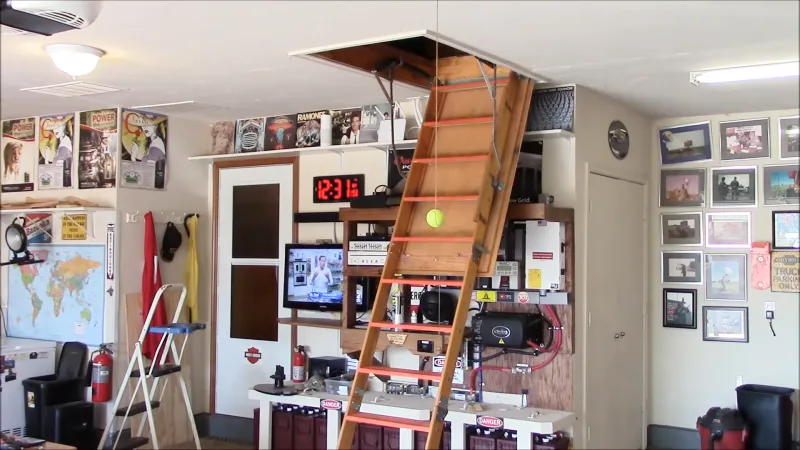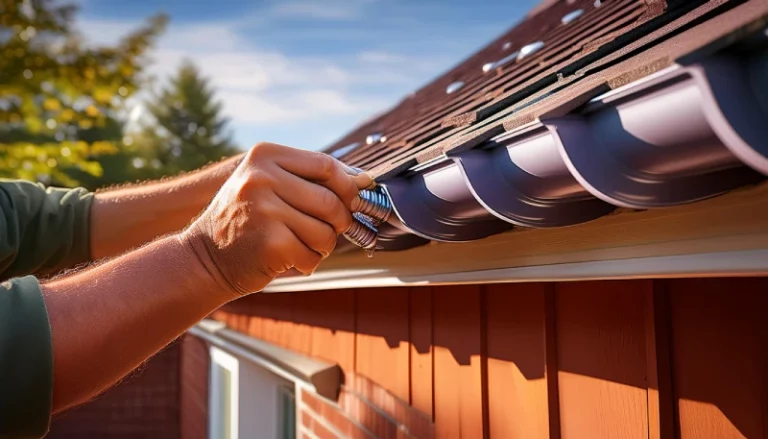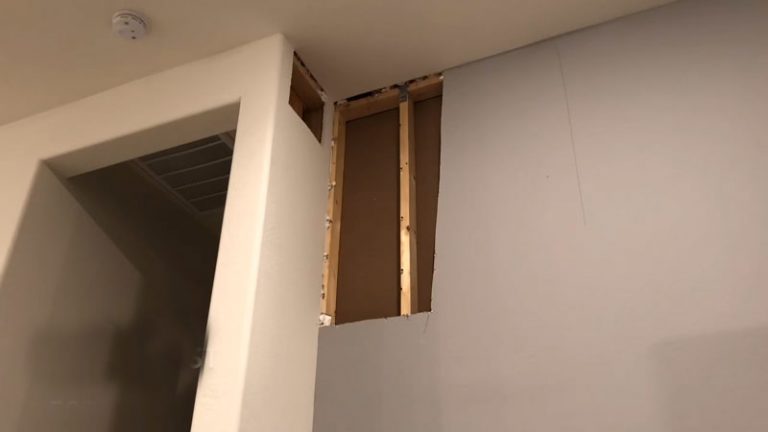How to Fix Attic Ladder Arm Bent?
An attic ladder is an essential component of a home that provides easy access to the attic space. A well-functioning attic ladder allows homeowners to efficiently utilize their attic as storage or additional living space.
However, when the ladder arm is bent, the stability and safety of the ladder are compromised, making it difficult or even impossible to use. In this blog, we will explore the issue of a bent arm in attic ladders and discuss potential causes and solutions.
You'll Learn About
Symptoms of a Bent Arm
An attic ladder is a type of ladder that provides access to an attic space. It is typically installed in the ceiling of a home and is used to access storage or living space in the attic.
Attic ladders come in different sizes, materials, and styles to accommodate different types of attics and meet different needs.
The arm of an attic ladder is an important component that helps to support the ladder and ensure smooth and safe operation. If the arm is damaged, bent, or otherwise not functioning properly, it can result in a number of problems that make it difficult or even dangerous to use the ladder.
A bent arm is one of the most common problems that can occur with an attic ladder. This issue is often caused by overuse, improper use, or accidental damage. When the arm is bent, it can cause a number of symptoms that make it difficult or even dangerous to use the ladder.

Symptoms of a Bent Arm
Difficulty in Opening and Closing the Ladder
The arm provides support and stability to the ladder, so when it is bent, it can make it difficult to open and close the ladder. The ladder may become stuck or require extra effort to open and close, which can be frustrating and even dangerous.
Noisy Operation
A bent arm can also cause the ladder to make a loud, creaking noise when it is being opened or closed. This noise is caused by the metal bending and twisting, which can be a sign of serious damage to the arm.
Uneven or Wobbly Movement
Finally, a bent arm can cause the ladder to move unevenly or become wobbly when it is being used. This can make it difficult to climb up and down the ladder, and can even be dangerous if the ladder becomes unstable and tips over.
A bent arm is a serious issue that can make it difficult and dangerous to use an attic ladder. If you are experiencing any of the symptoms described above, it is important to address the problem as soon as possible to ensure the safety and functionality of your attic ladder. Whether you need to replace the arm or have it repaired, taking action quickly can help to prevent further damage and ensure that your ladder is safe and reliable for years to come.
Causes of a Bent Arm
A bent arm on an attic ladder can cause a number of problems and make it difficult or even impossible to use the ladder. Understanding the causes of a bent arm can help you avoid the issue in the first place or take appropriate action if it does occur.
Wear and Tear
Wear and tear is one of the most common causes of a bent arm on an attic ladder. Over time, the metal of the arm may become worn and weakened, causing it to bend under pressure. This is particularly likely if the ladder is used frequently and the arm is subjected to regular stress.
Overloading
Another cause of a bent arm is overloading. If the ladder is designed to support a certain weight and this weight limit is exceeded, the arm may bend under the strain. This can be particularly problematic if the ladder is being used to move heavy items into the attic, as the arm may become bent even if the person using the ladder is not excessively heavy themselves.
Poor Installation
Finally, poor installation can also lead to a bent arm on an attic ladder. If the ladder is not installed correctly, the arm may become bent due to misalignment or uneven pressure. This is why it’s important to follow the manufacturer’s instructions carefully when installing an attic ladder and to have it professionally installed if you’re not confident in your own DIY skills.
there are several factors that can contribute to a bent arm on an attic ladder. Understanding these causes can help you avoid the issue in the first place or take appropriate action if it does occur. If you suspect that your attic ladder arm is bent, it’s important to address the issue promptly to ensure the safety of those using the ladder and to prevent further damage.
Diy Solutions to Fix a Bent Arm
A bent arm on an attic ladder can be frustrating, but it can often be fixed with a few simple DIY steps. Here are some solutions to consider if you are facing this problem.
Step-by-step Instructions to Bend the Arm Back Into Shape
Locate the Bent Arm
Before attempting to fix the bent arm, you need to locate it. If the ladder is still installed, you may be able to see the bent arm from below. If not, you will need to remove the ladder and inspect it closely.
Use a Vice
If the bend is minor, you may be able to use a vice to gently bend the arm back into shape. Make sure that you secure the arm firmly in the vice and that you use a soft cloth to protect it from damage.
Use a Hammer
If the bend is more pronounced, you may need to use a hammer to gently tap the arm back into place. Start by tapping the side of the arm opposite the bend, and work your way around the arm until it is straight.
Removing the Pivot Pin and the Mounting Plate, and Replacing Them With a Bolt and Washers
Remove the Pivot Pin
To remove the pivot pin, you will need to find the small pin that holds the arm in place. This is usually located near the top of the arm. Use a pair of pliers to gently remove the pin.
Remove the Mounting Plate
Next, remove the mounting plate that holds the arm in place. This is typically located near the bottom of the arm. Use a screwdriver to remove the screws that hold the plate in place.
Replace the Pivot Pin and the Mounting Plate
Once the pivot pin and mounting plate have been removed, you can replace them with a bolt and washers. Start by placing a washer over the end of the bolt and threading it through the arm. Then, place another washer over the end of the bolt and tighten it with a nut.
Considerations for the Diy Repair, Such as the Necessary Tools and Materials
- Tools: To complete the DIY repair, you will need a vice, a hammer, pliers, a screwdriver, a bolt, washers, and a nut.
- Materials: You will also need a soft cloth to protect the arm from damage and a piece of wood or a cushion to place under the arm when you are working on it.
Fixing a bent arm on an attic ladder is a relatively simple DIY project that can be completed with a few basic tools and materials. Before you begin, make sure that you have all of the necessary tools and materials on hand and that you take the time to understand the steps involved in the repair process.
Professional Solutions to Fix a Bent Arm
If you’re experiencing difficulty with your attic ladder due to a bent arm, one option is to purchase a replacement arm from the manufacturer. This is a straightforward solution that will ensure you get an arm that is specifically designed for your ladder and is guaranteed to fit properly. This can be done online or at a local home improvement store.
Hiring a Professional Repair Service
Another option for fixing a bent arm is to hire a professional repair service. This may be necessary if the bend is significant and cannot be corrected through DIY methods or if you do not have the necessary tools or skills to repair the arm yourself. A professional repair service will have the expertise and equipment to quickly and effectively resolve the issue, ensuring that your attic ladder is functioning properly again.
Considerations for Choosing Professional Repair
When considering professional repair, it is important to take into account the cost and time involved. Professional repair services can be expensive, and the cost will depend on the extent of the damage and the location of the service provider. Additionally, you may need to wait for an available appointment, which can take time.
a bent arm can cause significant problems with your attic ladder, making it difficult to open and close and potentially putting you at risk of injury. While there are DIY solutions available, these may not be suitable for everyone, and hiring a professional repair service may be the best option for ensuring the safety and functionality of your attic ladder.
Prevention Measures
One of the most effective ways to prevent a bent arm on an attic ladder is to perform regular maintenance. This involves inspecting the ladder and making any necessary repairs or replacements to keep it in good working condition.
This could include tightening loose screws or bolts, replacing worn or damaged parts, and lubricating the moving parts. Regular maintenance can help to prolong the life of the ladder and prevent the need for major repairs in the future.
Proper Usage Guidelines
Another way to prevent a bent arm on an attic ladder is to follow proper usage guidelines. This involves being careful when opening and closing the ladder, avoiding overloading the ladder with heavy items, and being mindful of the weight limit.
It’s also important to ensure that the ladder is installed correctly and that it is level and stable. Proper usage guidelines can help to reduce the risk of damage and ensure that the ladder operates smoothly and safely.
Checking for Signs of Wear and Damage and Fixing Them Promptly
Finally, it’s important to check the attic ladder regularly for signs of wear and damage, such as bent arms, loose or worn parts, or other signs of wear. If any issues are found, it’s important to address them promptly to prevent further damage and ensure that the ladder continues to operate safely. Regular inspections and timely repairs can help to keep the attic ladder in good working condition and prevent the need for costly repairs in the future.
A bent arm on an attic ladder can be a frustrating problem, but it can be prevented with regular maintenance, proper usage guidelines, and prompt attention to signs of wear and damage. By following these steps, homeowners can ensure that their attic ladder remains in good working condition and continues to provide safe and easy access to their attic for years to come.
Tips for Maintaining an Attic Ladder Arm
Maintaining your attic ladder arm is essential to keep it functioning properly and to extend its lifespan. Here are some additional tips that can help you keep your attic ladder arm in top condition:
Store the Ladder Properly
When not in use, it is crucial to store the ladder in a dry and cool place. Exposure to extreme heat and moisture can cause the ladder arm to warp, bend, or rust, which can lead to more significant problems.
Lubricate the Hinges
Regularly lubricating the hinges of your attic ladder arm with a silicone-based spray can help reduce friction, prevent rust, and keep the arm functioning smoothly.
Avoid Overloading
Always observe the weight limit of your attic ladder arm and do not exceed it. Overloading can cause excessive stress on the arm and can result in a bend or break.
Inspect the Arm Regularly
Regularly inspecting the arm for any signs of wear or damage, such as cracks, dents, or rust, can help you catch and fix problems before they become more severe.
Use a Ladder Stabilizer
If you have an extension ladder that can be attached to the roof, it may be wise to use a ladder stabilizer to prevent the ladder from wobbling and causing stress on the arm.
By following these tips, you can keep your attic ladder arm functioning properly and extend its lifespan. If you have any concerns about your attic ladder arm, it is best to consult a professional for advice and repairs.
Editor’s Note
It appears that the issue is with the bent arm of an attic ladder and the pivot pin which connects the arm to the ladder frame. The cause of the arm bending could be due to wear and tear, overuse or improper use of the ladder.
To fix the issue, one suggestion is to bend the arms back into shape and check if the ladder works properly. If the issue persists, one could remove the pivot pin and mounting plate, and replace them with a bolt and washers.
It’s advisable to consult the manufacturer’s instructions or customer service for the specific model.
What is the Purpose of an Attic Ladder Arm?
The attic ladder arm is an essential component of an attic ladder, which provides support to the ladder as it opens and closes. The arm is attached to the ladder and the ceiling, allowing the ladder to be safely raised and lowered.
The arm is designed to bear the weight of the ladder and the person using it, so it is important that it is in good condition and functioning properly.
How Can You Tell if the Attic Ladder Arm is Bent?
There are several signs that the attic ladder arm is bent, including difficulty opening and closing the ladder, noisy operation, and uneven or wobbly movement. If the ladder is difficult to open or close, it may be a sign that the arm is bent and unable to support the weight of the ladder.
if the ladder makes excessive noise or moves unevenly, it may also indicate that the arm is bent.
What Are Some Common Causes of a Bent Attic Ladder Arm?
The most common causes of a bent attic ladder arm are wear and tear, overloading, and poor installation. Over time, the arm can become worn and weakened, which can cause it to bend or break. Overloading the ladder, such as by carrying heavy items up to the attic, can also cause the arm to bend.
poor installation, such as not securing the arm properly or installing it in an incorrect location, can also result in a bent arm.
Can a Bent Attic Ladder Arm Be Fixed, and if So, How?
A bent attic ladder arm can often be fixed, either through a diy repair or by hiring a professional repair service. To fix a bent arm, the arm can be bent back into shape or the pivot pin and mounting plate can be removed and replaced with a bolt and washers.
alternatively, a replacement arm can be purchased from the manufacturer, or a professional repair service can be hired. When deciding on a solution, it is important to consider the necessary tools and materials, as well as the cost and time involved.
What Can Be Done to Prevent a Bent Attic Ladder Arm?
To prevent a bent attic ladder arm, it is important to regularly maintain the attic ladder and check it for signs of wear and damage. This may involve cleaning the ladder and checking the arm for any signs of bending or wear.
proper usage guidelines, such as not overloading the ladder or carrying heavy items up to the attic, can also help to prevent a bent arm. If any signs of wear or damage are detected, it is important to address them promptly to prevent the arm from bending.
Conclusion
A bent attic ladder arm is a common issue that can be easily fixed either through DIY solutions or by hiring a professional repair service. It is important to address this issue promptly, as a bent arm can make the ladder difficult to open and close, and can cause uneven or wobbly movements.
Regular maintenance and proper usage guidelines can help prevent the arm from bending in the first place. In summary, taking the necessary steps to fix a bent attic ladder arm will ensure that it continues to function properly and provide safe access to your attic.
While repairing your attic ladder, consider other home maintenance tasks. For example, learning why the top piece of vinyl siding keeps falling off can improve your home’s exterior. Additionally, understanding how to handle acorns falling on your roof can protect your home from potential damage. For more tips, check out our guide on installing gutter screws through a drip edge.



